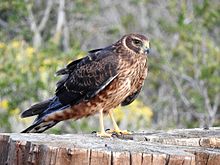Gray harrier
| Gray harrier | ||||||||||||
|---|---|---|---|---|---|---|---|---|---|---|---|---|

Gray harrier, female |
||||||||||||
| Systematics | ||||||||||||
|
||||||||||||
| Scientific name | ||||||||||||
| Circus cinereus | ||||||||||||
| Vieillot , 1816 |
The gray harrier ( Circus cinereus ) is a medium sized type of orders , which is widespread in South America and for a marked sexual dimorphism is characteristic. The females, which are up to a quarter larger, are mostly brown on the upper side of the body, while the males are gray. In both cases the underside of the body is cross-banded white and brown.
The IUCN specifies that the gray harrier is not at risk ( least concern ). No subspecies are distinguished.
Appearance
Dimensions and feathered body parts
The gray harrier reaches a body length of 39 to 48 centimeters, of which 20 to 25 centimeters in males and 23 to 28 centimeters in females are on the tail. The wings have a length of 30 to 34 centimeters in the males and 34 to 37 centimeters in the females. The wingspan is 90 to 115 centimeters. The weight of the males is between 315 and 407 grams, the females weigh between 427 and 510 grams. The eyes of adult birds are yellow. The beak is yellow, the wax skin is yellow to greenish yellow. The legs and feet are orange-yellow.
male
In the male, the head, front chest and side of the body are mostly gray. The back and the elytra a little darker. The tail plumage has diffuse black end bands. The lower chest, abdomen and thighs are white with a noticeable reddish-brown transverse banding.
The gray plumage can be seen in males from the age of six months. It first shows up on the head and on the front chest. Males in the second year of life still have a slightly gray-brown tone on the upper side of the body.
female
Females are dark brown to dark maroon on the top of the body. The individual feathers are brightly lined and they also have individual cream-colored and gray-white spots. The base color of the underside of the body is white, the throat is very dense brown, with vertical lines. The chest is cross-banded in dark brown and the rest of the underside of the body is red-brown cross-dashed as in the male.
Young birds are initially feathered like the female, regardless of gender, but are more black-brown on the upper side of the body.
Distribution area and habitat
The distribution area of the gray harrier stretches from the Andes of Colombia and Ecuador via Peru and Bolivia to Tierra del Fuego . Non-breeding gray harriers can occasionally be seen in Paraguay, northeast Argentina , and Uruguay . On the Falkland Islands , where they originally appeared, they are only occasionally a stray visitor . The gray harrier occurs partly in the high Andes and can occasionally be found at an altitude of 4500 meters. However, in some regions, including the coastal areas of Bolivia and Peru, it also occurs in the lowlands. However, it is more typical in mountain regions. It occurs in the north-west of Argentina at large lakes in mountain valleys at altitudes of around 3000 meters.
In most of the distribution area, the gray harrier is a resident bird . Populations in Patagonia move north in April to May, the beginning of the southern winter half-year, and return in the months of September to October. In the lowlands of Argentina, in Uruguay and in the extreme southeast of Brazil, however, it is a partial migrant . In the populations living in the Andes, there is presumably a seasonal high-altitude migration.
The habitat is open terrain, but especially marshes, reeds in the grasslands and spacious bogs.
Way of life
The gray harrier usually lives solitary or in pairs. Several individuals can gather at resting places and in the vicinity of abundant food.
The food spectrum of the gray harrier has not yet been conclusively investigated. However, it probably covers most of its food supply with small mammals and birds. It regularly eats the nestlings of coots and other birds of the wetlands. It also eats iguanas , insects and frogs. While searching for food, it flies over large parts of its respective range and occasionally only two to five meters above the ground. Males have also been observed flying up from a hide in order to prey on birds. Gray harriers, however, are not typical high-seat hunters.
Reproduction
Compared to the white- browed harrier, which also occurs in South America , the breeding season of the gray harrier is shorter. It falls in the south of the distribution area between October and January, with oviposition generally not starting before mid-November. The nestlings fly out in January.
The nest is a platform made of reeds, grass and similar platform and has a height of 10 to 30 centimeters and a diameter of 30 to 40 centimeters. Occasionally they also build their nests in shallow water, then they usually use the nests of coots as a basis and build their nesting platforms on them. In these cases the platform can be up to 3 meters high. The clutch usually consists of three to four eggs. The breeding season is about 30 days. The nestling time is not yet known.
literature
- J. Ferguson-Lees, DA Christie: Raptors of the World. Christopher Helm, London 2001, ISBN 0-7136-8026-1 .


